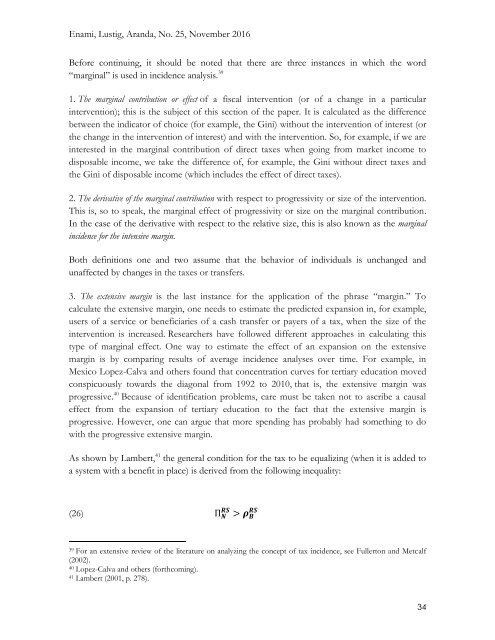IMPACT OF TAXES AND TRANSFERS
n?u=RePEc:tul:ceqwps:25&r=lam
n?u=RePEc:tul:ceqwps:25&r=lam
Create successful ePaper yourself
Turn your PDF publications into a flip-book with our unique Google optimized e-Paper software.
Enami, Lustig, Aranda, No. 25, November 2016<br />
Before continuing, it should be noted that there are three instances in which the word<br />
“marginal” is used in incidence analysis. 39<br />
1. The marginal contribution or effect of a fiscal intervention (or of a change in a particular<br />
intervention); this is the subject of this section of the paper. It is calculated as the difference<br />
between the indicator of choice (for example, the Gini) without the intervention of interest (or<br />
the change in the intervention of interest) and with the intervention. So, for example, if we are<br />
interested in the marginal contribution of direct taxes when going from market income to<br />
disposable income, we take the difference of, for example, the Gini without direct taxes and<br />
the Gini of disposable income (which includes the effect of direct taxes).<br />
2. The derivative of the marginal contribution with respect to progressivity or size of the intervention.<br />
This is, so to speak, the marginal effect of progressivity or size on the marginal contribution.<br />
In the case of the derivative with respect to the relative size, this is also known as the marginal<br />
incidence for the intensive margin.<br />
Both definitions one and two assume that the behavior of individuals is unchanged and<br />
unaffected by changes in the taxes or transfers.<br />
3. The extensive margin is the last instance for the application of the phrase “margin.” To<br />
calculate the extensive margin, one needs to estimate the predicted expansion in, for example,<br />
users of a service or beneficiaries of a cash transfer or payers of a tax, when the size of the<br />
intervention is increased. Researchers have followed different approaches in calculating this<br />
type of marginal effect. One way to estimate the effect of an expansion on the extensive<br />
margin is by comparing results of average incidence analyses over time. For example, in<br />
Mexico Lopez-Calva and others found that concentration curves for tertiary education moved<br />
conspicuously towards the diagonal from 1992 to 2010, that is, the extensive margin was<br />
progressive. 40 Because of identification problems, care must be taken not to ascribe a causal<br />
effect from the expansion of tertiary education to the fact that the extensive margin is<br />
progressive. However, one can argue that more spending has probably had something to do<br />
with the progressive extensive margin.<br />
As shown by Lambert, 41 the general condition for the tax to be equalizing (when it is added to<br />
a system with a benefit in place) is derived from the following inequality:<br />
(26) П N RS > ρ B<br />
RS<br />
39 For an extensive review of the literature on analyzing the concept of tax incidence, see Fullerton and Metcalf<br />
(2002).<br />
40 Lopez-Calva and others (forthcoming).<br />
41 Lambert (2001, p. 278).<br />
34



